DATA
MINING YIELDS MYSTERIOUS
CONSERVED GENE FAMILY
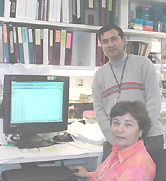 |
|
NEI's
Cynthia Jaworski and Shahabuddin Alam
|
NEI’s Cynthia Jaworski says she loves "to play in front of the computer." It was this playing that led her and Shahabuddin Alam and Nataliya Gordiyenko in Ignacio Rodriguez’s NEI lab to discover the 12 genes encoding human oxysterol-binding proteins (OSBPs) and then, more deliberately, to find mouse orthologs for these genes.
The group began mining mouse data when its lab work showed some unusual transcripts in the human versions of the proteins, which are expressed in retina, brain, liver, kidney, heart, spleen, lung, and the organ of Conti in the ear, for example. Jaworski found very similar orthologs for each of the human OSBPs in the mouse.
Greatest similarity between mouse and human lay in pleckstrin homology domains, which were completely identical for several of the OSBPs. Jaworski says the genes are found beyond mammals—in yeast (7 genes), worms (5 genes), fruit flies (4 genes), and plants (12 genes in Arabidopsis), for example.
Knocking out the genes in yeast points to a high degree of interchangeability or redundancy in their function, Jaworski says. "You have to knock out the whole family to see a lethal effect in yeast."
These features of the OSBPs suggest that they must be important in the life of the cell. And just what is this critical function? It’s not yet clear, Jaworksi says. With a little arm-twisting, she mentions that some folks think OSBPs might have a role in vesicular trafficking.
From here, the lab
could move on to designing knockout mouse-model experiments to see whether
any knockout results in retinal damage. Jaworski is quite certain of one
thing: With the growth of gene and protein databases for a cornucopia
of organisms, data-mining work like hers will be very much a part of the
future of genetic research—quickly pointing to commonalities in the
regulation of genes and directing searches for function. "I think
that the current wave of data-mining will continue until the human genome
is not only completely sequenced, but also completely annotated and understood,"
Jaworski predicts. ![]()
PHARMACOKINETIC
DATA INVITE NEW
LOOK
AT VITAMIN C AS
CANCER THERAPY
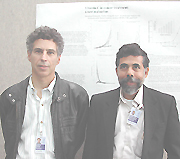 |
|
NIDDK's
Mark Levine (left) and Sebastian Padayatty
|
Nutritional bioavailability studies undertaken by NIDDK investigators to update the RDA for vitamin C have cast new light on old studies that dismissed vitamin C as an anticancer agent. The findings are considered intriguing enough by NCI’s Office of Cancer Complementary and Alternative Medicine (OCCAM) to be used as a starting point for a phase I trial to reevaluate vitamin C’s possible role in cancer treatment.
"We chanced upon this," said Sebastian Padayatty, of the Molecular and Clinical Nutrition Section, Digestive Diseases Branch, NIDDK.
"We were studying vitamin C pharmacokinetics—from a nutritional point of view, looking for the correct daily intake—and saw a huge difference in bioavailability following oral and i.v. administration. We were also aware of the controversy over vitamin C in cancer treatment in the 1980s, when no one had i.v. pharmacokinteic information. That whole issue immediately—and naturally—came to mind."
Elaborating on their poster at the Research Festival, Padayatty and co-investigator Mark Levine, chief of the Clinical Nutrition Section, recounted the vitamin C–cancer history: In the 1970s, Ewan Cameron and Allan Campbell reported that high-dose (10 g) vitamin C yielded clinical benefit and prolonged survival in terminal cancer patients, a finding later repeated in large retrospective studies conducted by those two investigators in collaboration with Linus Pauling.
There was considerable debate over the validity of these findings—since the studies were not randomized or controlled—and when Charles Moertel and his colleagues at the Mayo Clinic tested the same vitamin C dose in two NCI-supported randomized, controlled clinical trials and found no vitamin C effect, most of the scientific community dropped vitamin C from consideration as a cancer therapy.
There was one hitch, however, that was not appreciated until the NIDDK investigators undertook their nutrition studies some 15 years later: Vitamin C was delivered intravenously in the studies that reported benefit, and it was delivered orally in the Moertel studies.
In pharmacokinetics simulation studies and in studies with healthy volunteers, presented at the Research Festival, the NIDDK team (Levine and Padayatty and colleagues Yao-Hui Wang and Arie Katz and He Sun at the FDA) established that vitamin C plasma concentrations after i.v. administration are at least tenfold those generated by oral administration. Differences in urinary concentrations were similarly dramatic.
The i.v. route produced millimolar concentrations that are known to be toxic to a variety of cancer cell lines, Levine noted. He added that recent anecdotal case reports from some private CAM clinicians—with pathology confirmed by an NCI pathologist—suggest that megadose i.v. vitamin C may help some patients with advanced genitourinary cancers.
"We’re always skeptical of case reports—and in vitro apoptosis could reflect cell culture artifact," Levine said, "but it all points to the need for further scientific study."
Jeffrey White, director of the NCI OCCAM, agrees. "The pharmacokinetic data, along with other recent findings, justify a careful investigation of the therapeutic potential of intravenous vitamin C," he said.
White, Levine, and
others from the NIDDK lab and NCI, White added, "have had preliminary
discussions and are in the early concept phase of developing a clinical
protocol for a phase 1 trial." ![]()
TOWARDS TOLEROGENIC TRANSPLANTS
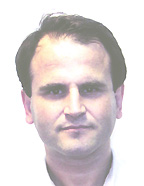 |
|
Edip
Akpinar
|
For a few years, scientists have had an enticing idea for how to induce the body to accept a transplant of non-self tissue from a donor: Give a tolerogenic transplant of bone marrow to reprogram a recipient’s immune system to accept an organ transplant as "self." This induced natural tolerance would permit a heart, kidney, or pancreatic islet cell recipient, for example, to live indefinitely with a transplant, without having to take immunosuppressive drugs.
Evidence—in mice—has hinted that the scheme might work. At the Research Festival, Edip Akpinar, working in David Harlan’s NIDDK lab with Nancy Craighead, Jenny Park, and Douglas Hale, revealed some key tricks they have discovered that could bring tolerogenic transplants a few steps closer to practice.
Working with mice, the scientists identified and collected a strongly tolerogenic population of cells—bone marrow cells that are positive (bright) for c-Kit, the receptor for stem cell factor. Although the c-Kit–positive cells constitute only 4–5 percent of the cells in marrow, the great news was that these cells grew "like crazy" in culture, Akpinar says, increasing better than 250-fold and producing immune tolerance equal to that from whole bone marrow. The NIDDK group tested tolerance with the most immunogenic transplants possible: skin grafts between mice that were complete genetic mismatches. In addition to permitting smaller, simpler telerogenic transplants, using a subpopulation of bone marrow is also less likely to have unwanted side effects, such as graft vs. host and host vs. graft reactions, Akpinar observes.
Members of the NIDDK group are currently conducting trials on immune tolerance induction in monkeys using bone marrow, with trials in kidney transplant patients expected to begin early next year. They plan to extend to primates what they learned from mice about fractionation of the marrow for c-Kit–positive cells. Until those experiments yield results, Akpinar reminds cautiously that, "It is easier to achieve tolerance in small rodents than in primates."
INTRA-NUCLEAR SPACE: THE FINAL FRONTIER?
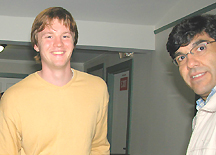 |
|
Jeff
Roix (left) and Luis Parada
|
Two posters facing one another at the Research Festival raised the provocative suggestion that it is not just the proteins your genes encode that are important, but also the physical location of your genes and chromosomes within the nucleus.
Poster CB-8, presented by Jeff Roix, from Tom Misteli’s NCI lab, studied nuclear positioning of loci disrupted in Burkitt’s lymphoma. Poster CB-9, presented by Luis Parada, also in Misteli’s lab, used chromosome painting to detect consistent patterns in the relative position of chromosome pieces in other cancerous and normal cell lines. Parada’s work is published in the Oct. 1 issue of Current Biology (12:1692–1697, 2002).
Roix and Parada, who also collaborated with CIT’s Philip McQueen and Peter Munson, along with Misteli, say measuring the relative location of genes and chromosomes is technically very challenging. Nevertheless, they were able to detect consistent patterns, and they say these probably reflect positions of entire chromosomes, not just the specific loci they examined.
What are the causes and consequences of this subnuclear spatial patterning of the genome? It’s not yet clear, the pair say. Some evidence, published in Nature (418:975–979, 2002) points to interphase sequence clustering of myogenesis genes in Caenorhabditis elegans. But it’s not known if interphase location of chromatin determines the arrangement of chromosomes—or vice versa.
As for consequences, Roix and Parada say proximity of loci may contribute to increased frequency of translocation between them. This can result in cancer and other deleterious gene changes. But understanding the gene regulatory advantages of proximity—during interphase, presumably—awaits further research. This final frontier, they say, could benefit from better methods for analyzing intranuclear space.
KILLING CANCER THROUGH COPPER CHELATION
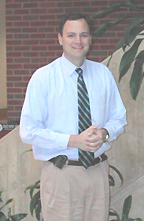 |
|
Kevin
Camphausen
|
Cancer researchers think a key vulnerability of tumors lies in the way they aggressively commandeer angiogenesis. Induction of new vessels feeds tumor growth, and if scientists could inhibit angiogenesis, they could cut off the nutrient pipeline to expanding tumors.
NCI tenure-track investigator Kevin Camphausen knew that copper was somehow important to angiogenesis, and he speculated that if he could mop up copper with a chelator before endothelial cells got it, perhaps he could block angiogenesis.
Camphausen asked his colleague Martin Brechbiel to make some copper chelators. Brechbiel sent him 40 chelators in a brown box. Working also with Mary Sproull, Steve Tantama, Tamalee Scott, and Cynthia Menard, Camphausen tested the compounds for their ability to inhibit angiogenesis (the growth of human umbilical vein endothelial cells).
The winner was #20, a member of the tachpyridine family of compounds. Members of the tachpyr family were effective in blocking the growth of endothelial cells in vitro, but did not harm other types of cells the team tested.
As small molecules, the tachpyrs have excellent potential as drugs. If they pan out as angiogenesis inhibitors, they would have two additional advantages over other anti-angiogeneic proteins such as angiostatin and endostatin: Tachpyrs are much easier and cheaper to make, and their uptake could make cells sensitive to radiation. This trait enables tachpyr to deliver a doubly deadly blow to tumors.
Camphausen does not yet know which molecules in angiogenesis are so voracious for copper, but plans to find out. The group will also be working with collaborators to refine the tachpyrs and move them to in vivo animal trials.
 |
|
Jesus
Salvador
|
One serious challenge for the study of autoimmune disease in general, and lupus in particular, has been a lack of good animal models.
At the Research Festival, Jesus Salvador, of the NCI Gene Response Section, Basic Research Laboratory, offered a promising new autoimmune disease mouse model: the Gadd45g knockout.
The NCI group—including lab chief Albert Fornace, Christine Hollander, Heraa Haj-Elsafi, Chui Cheng, Anh Thu Nguyen, Svetlana Speransky (Germline Mutation Core Facility), and Jonathan Ashwell (Laboratory of Immune Cell Biology)—has now deduced that genes in the Gadd45 family appear to be autoimmunity suppressor genes. The team has published a report, with NIDDK collaborators Jeffrey Kopp and Laura Barisoni, on its knockout of the Gadd45a gene (Immunity 16:499–508, 2002), is soon to publish on the Gadd45g knockout, and eventually hopes to knock out the entire family of Gadd45 genes.
Salvador says the Gadd45g knockout is not a perfect mimic of lupus, but does exhibit leukopenia, lymphopenia, and proteinuria, as found in the disease. Also present are high titers of antibodies to double-stranded and single-stranded DNA and to histones. These antibodies and proteinuria are present in the MRL mouse—the best mouse model scientists had developed before—but the MRL mouse does not have the leukopenia and lymphopenia found in the NCI mouse and in most people with systemic lupus erythmatosus.
Salvador says that T cells derived from Gadd45 knockout mice have a hyperproliferative response and lower threshold of activation than wild-type cells. The group proposes that the hyperproliferation of T cells is sufficient to provoke the loss of tolerance that leads to the development of this autoimmune disease. Thus, the Gadd45 knockouts may prove to be good models for several autoimmune diseases.
USING PROTEOMICS TO DIAGNOSE INTERSTITIAL CYSTITIS
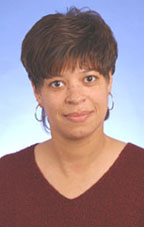 |
|
DaRue
Prieto
|
Interstitial cystitis (IC) is a chronic inflammation of the epithelium that lines the bladder. The resulting pelvic pain, frequency of urination, and psychological consequences afflict between 450,000 and 700,000 people, mostly women, in the United States. As common and painful as IC is, to date its diagnosis has been by exclusion of infections and other disorders, resulting in an inefficient, protracted, and expensive ordeal for patients.
DaRue Prieto of NCI’s SAIC contract at Frederick worked with scientists from NCI, SAIC, the University of Maryland, and FDA-CBER—including Thomas Conrads, Susan Keay, Vincent Fusaro, Emanuel Petricoin, Lance Liotta, Haleem Issaq, and Timothy Veenstra—on a promising new way to identify the disease more directly. The group’s poster at the Research Festival demonstrated that SELDI-TOF/QqTOF could be used to recognize patterns of proteins in the urine of people with IC and distinguish these from samples taken from people who did not have the condition.
After "training" an artificial intelligence–based computer algorithm (developed by Ben Hitt at Correlogic Systems, Inc.) to distinguish the protein patterns in 50 urine samples from IC patients and 30 normal controls, the team tested the system on a 37-sample testing set that included 16 control subjects and 21 IC samples. The proteomics recognition was perfect, with 100 percent specificity and sensitivity.
Prieto presented the poster just one day after NCI scientists, working with colleagues from the FDA, academia, and Correlogic Systems, Inc., published studies in the Journal of the National Cancer Institute (94:1576–1578, 2002) showing that a similar proteomics/informatics analysis could be used on blood samples to identify men with prostate cancer more efficiently and accurately than is possible with prostate-specific antigen.
 |
|
Aaron
Bobb
|
In a poster sure to stimulate household debates, second-year NIMH summer student Aaron Bobb looked at how sex roles—the masculinity or femininity of husbands and wives—affected marital adjustment, or sense of satisfaction with their marriage.
Working in the laboratory of NIMH’s Carolyn Zahn-Waxler, Bobb analyzed data on the parents of children enrolled in an unrelated NIH study. The Cornell senior used the Bem Sex Role Inventory to gauge the husbands’ and wives’ sex roles and the Dyadic Adjustment Scale to rate their self-assessed marital satisfaction.
On the Bem scale, "masculine" people rate themselves high for traits such as forcefulness, athleticism, analytical ability, dominance, and independence; "feminine" people rate themselves high for being compassionate, affectionate, loyal, sensitive to the needs of others, and loving children. Those with high values for both "masculine" and "feminine" traits are classified as "androgynous," and those scoring low on both sets are classified as "undifferentiated."
The only relationship Bobb detected between sex role combinations and marital satisfaction was that "femininity" in both husband and wife correlated with greater personal satisfaction in the marriage. "Masculinity" had neither positive or negative correlations, and no optimal combination of men’s and women’s roles emerged: The marriage of a feminine woman and a masculine man appeared no more satisfying than the reverse, for example.
Bobb acknowledges that the study begs for follow-up. He plans to return to NIH after graduation and before going on to graduate study in psychology.
HEPATITIS E VACCINE PROVES SAFE AND EFFECTIVE IN MACAQUES; RESULTS PENDING IN HUMANS
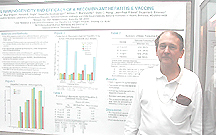 |
|
Robert
Purcell
|
NIAID investigators have engineered a recombinant vaccine that protects macaques against hepatitis E and is now in clinical trials to test its mettle in humans.
"Hepatitis E virus [HEV] is the single most important cause of clinical hepatitis in adults in central and southeast Asia and the Indian subcontinent—and Afghanistan, where our troops are," noted Robert Purcell, as he fielded questions at the Research Festival.
The recombinant subunit construct—the HEV capsid protein in a baculovirus vector—proved safe and highly immunogenic in nonhuman primates, fully protecting against the disease and partially protecting against infection. The investigators established the optimal dose and schedule. Hepatitis A vaccine was used as the placebo control.
The expression of recombinant protein "turned out to be easy," said Purcell, chief of the Laboratory of Infectious Diseases Hepatitis Viruses Section, NIAID. He compared the HEV capsid protein construct to that of the hepatitis B envelope protein, the immunogenic ingredient of the "first recombinant vaccine ever licensed."
Should the HEV vaccine prove equally successful in humans, it will leave only hepatitis C without coverage, observed Purcell, who co-developed the hepatitis A vaccine and is also working on adding hepatitis C to the list of preventable hepatitis viruses.
Discovered in 1980, visualized in 1983, and sequenced in 1991, HEV is a scourge in those areas of the world vulnerable to waterborne epidemics, where the population would be exposed to the massive viral doses that lead to disease. The disease is uncommon in the United States and Europe, but up to 20 percent of those populations have HEV antibody, probably through low-dose exposure. HEV infects swine and rats and can be transmitted from them to nonhuman primates and "maybe to humans as well," Purcell said. Its overall 1 percent mortality rises to 20 percent in pregnant women.
A clinical trial involving several thousand members of the military in Nepal is in progress. The code will be broken, said Purcell, once 25 bona fide HEV cases are documented.
Purcell’s NIAID colleagues in this study were Hahn Nguyen, Ronald Engle, Doris Wong, and Suzanne Emerson.